Best RV Gear for Digital Nomads in 2025: Elevate Your Adventures
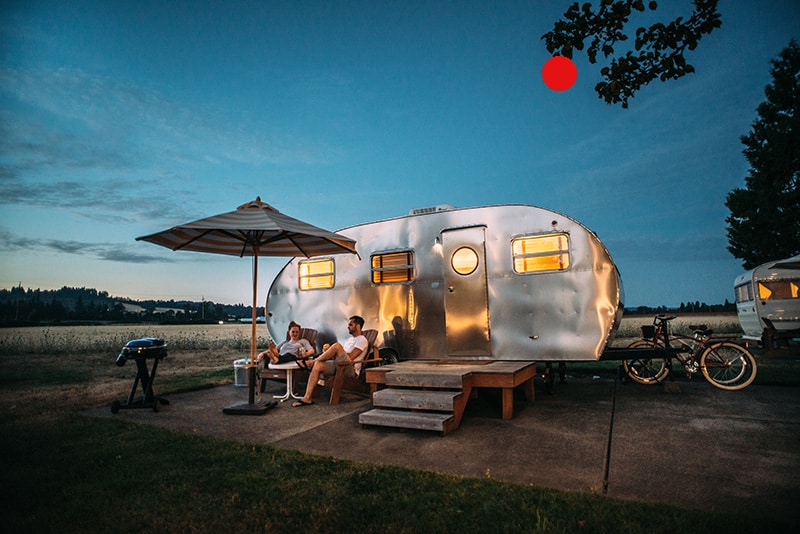
There’s a big difference between dreaming of RV life and actually hitting the road with a laptop, a dog, and a half-packed rig. As a part-time RVer and digital nomad, I’ve learned the hard way that the right gear can make or break your trip. A strong internet connection keeps you working, a good mattress means you’ll actually sleep, and clever storage hacks keep chaos at bay in a tiny space.
Whether you’re planning weekend getaways, seasonal road trips, or months of work-from-anywhere adventures, this guide covers the best RV gear for digital nomads, RV beginners, and part-time travelers — everything you need to stay comfortable, connected, and ready for the road.

This post may contain affiliate links. If you purchase through our partner links, we get paid for the referral at no additional cost. For more information, visit my disclosure page.
Quick Checklist: The Best RV Gear for Digital Nomads & Part-Time RVers
|
Connectivity: |
Best RV Internet Solutions: Starlink, hotspots, and Wi-Fi boosters to stay online. |
|
Mobile Office: |
Laptop stands, portable desks, and travel monitors. |
|
Comfort Gear: |
Best Portable AC, RV mattresses, blackout curtains, and climate control. |
|
Power & Energy: |
Best Solar panels, generators, and backup batteries. |
|
Kitchen Essentials: |
Compact cookware, Best RV water filters, and collapsible dishware. |
|
Pet Travel Gear: |
Portable bowls, travel beds, and cooling mats. |
|
Safety & Security: |
Door locks, cameras, and CO/propane detectors. |
Why Gear Matters for Part-Time RVers & Digital Nomads
Balancing comfort, work, and travel on the road
Hitting the road as a part-time RVer or digital nomad is about more than just getting from one destination to the next—it’s about balancing comfort, work, and travel. The right gear makes that possible. A reliable internet connection, ergonomic seating, and efficient power solutions ensure you can clock in for remote work just as easily as you can cook dinner by a campfire or relax after a long drive. Unlike vacation campers, digital nomads need to stay productive and connected without sacrificing the spontaneity and joy of travel. Good gear bridges that gap, letting you focus less on logistics and more on the adventure.
The unique needs of part-time vs. full-time RVers
The needs of part-time vs. full-time RVers are also different, and that shapes the gear you choose. Full-timers often invest in permanent upgrades—such as roof-mounted solar panels, composting toilets, or large lithium battery banks—because their RV serves as their home.
Part-timers, on the other hand, benefit more from modular, portable solutions, such as collapsible furniture, portable solar panels, and multi-use storage. These allow for easy setup when you’re on the road and minimal fuss when your RV is parked for weeks or months. Recognizing which camp you fall into helps you avoid overspending and ensures that the gear you bring truly enhances your lifestyle, rather than weighing it down.

Connectivity Essentials for Remote Work
Best Internet Options for RVers (Starlink vs. Hotspots)
For most digital nomads, internet access makes or breaks life on the road. The STARLINK Mini Kit, featuring a Wi-Fi Router, has quickly become the go-to option for reliable internet in remote areas. With coverage across most of North America, it’s a game-changer if you plan to boondock or camp outside of cities. It does, however, come with a higher upfront cost for the dish and a monthly subscription fee.
On the other hand, cellular hotspots (such as Verizon Jetpack, AT&T Nighthawk, or even your phone’s tethering plan) can be more affordable and work well in areas with strong cell tower coverage nearby. For part-time RVers who stick closer to towns and highways, a hotspot might be all you need. Many nomads keep both: a hotspot for everyday travel and Starlink for those far-flung locations where cell service drops out.
Comparison Table: Best RV Internet Options for Digital Nomads
| Product | Best For | Strengths | Limitations | Estimated Cost* |
|---|---|---|---|---|
| STARLINK Mini Kit – with Wi-Fi Router | Remote & off-grid locations | Satellite-based coverage, high speeds in remote areas | Higher upfront cost, may struggle under heavy foliage or in rain | Hardware ~$499–$600, subscription ~$37–$150/mo |
| Cellular Hotspots: Verizon Jetpack Hotspot AT&T Nighthawk | Urban, suburban, highway travel | Affordable, works where cell towers exist, portable | Coverage drops in rural zones, speed caps, data plans | Hardware ~$124 +, subscription: $21–$38/mo |
| Wi-Fi Booster / External Antenna: weBoost Drive Reach | Campgrounds & fringe coverage | Amplifies weak signals up to 32x, supports multiple devices | Doesn’t create a new service, needs an existing signal | Hardware ~$499 |
*Costs are approximate and will vary based on brand, model, and region.
Budget:
TP-Link N300 Mobile WiFi Hotspot — This pocket-sized Wireless router quickly creates a secure WiFi hotspot to share with family and friends, serving as an affordable backup for occasional use. A reliable backup when your primary connection fails. It won’t replace Starlink, but it’s dependable for lighter tasks, such as email or browsing.
Mid-Tier:
SpaceX Starlink Mini Satellite Dish — Portable Antenna with Advanced Phase Array Technology – High-Speed Internet Kit for RV, Camping, Remote Work. Provides internet connectivity up to 500 feet from the base unit, with 32 available channels for optimal signal strength, ensuring strong coverage in even the most remote areas. Hands-down the best coverage in remote areas.
Premium:
Peplink LTE Cellular Router — Carrier-agnostic, Dual CAT-12 LTE cellular modems with redundant SIM card slots ensure you stay connected at all times. This router is a beast. Dual SIM, active failover, and advanced settings make it ideal for digital nomads needing rock-solid connectivity.
Top RV Wi-Fi Boosters & Antennas
Even the best internet setup can struggle in crowded campgrounds or areas with limited coverage. That’s where Wi-Fi boosters and antennas come in. Products like Winegard ConnecT 2.0 or weBoost Drive Reach RV can dramatically improve your connection by pulling in weaker cell signals or extending campground Wi-Fi so you don’t drop out on Zoom calls.
While boosters can’t create service where none exists, they can take a single bar of signal and turn it into a usable connection. For anyone working remotely, a booster is one of the best investments to reduce frustration and improve reliability on the road.
Must-Have Travel Routers for Reliable Connections
A travel router ties your whole setup together. Think of it as your personal network hub inside the RV. Routers like the GL.iNet Slate AX or Pepwave B-One WiFi Router enable you to connect to campground Wi-Fi, plug in a hotspot, or even link to Starlink, and then securely rebroadcast that signal across all your devices. That way, your laptop, phone, and smart gadgets all stay connected to one consistent network, no matter how your internet source changes.
For digital nomads, this adds not just convenience but also a layer of security. Many travel routers include built-in VPN support, so you’re not relying on sketchy campground Wi-Fi to handle sensitive work tasks.
FAQ: What’s the best mobile hotspot for RV travel?
The best hotspot depends on your carrier coverage where you’ll be traveling. AT&T Nighthawk M6 Pro is a top choice for speed and reliability, while Verizon Jetpack 8800L is a long-time favorite for coverage across rural areas. If you’re a light data user, TravelFi, Pay As You Go HotSpot, or even a prepaid hotspot plan or tethering from your smartphone may be enough. For heavy work use, consider pairing a hotspot with a booster to maximize your connection.
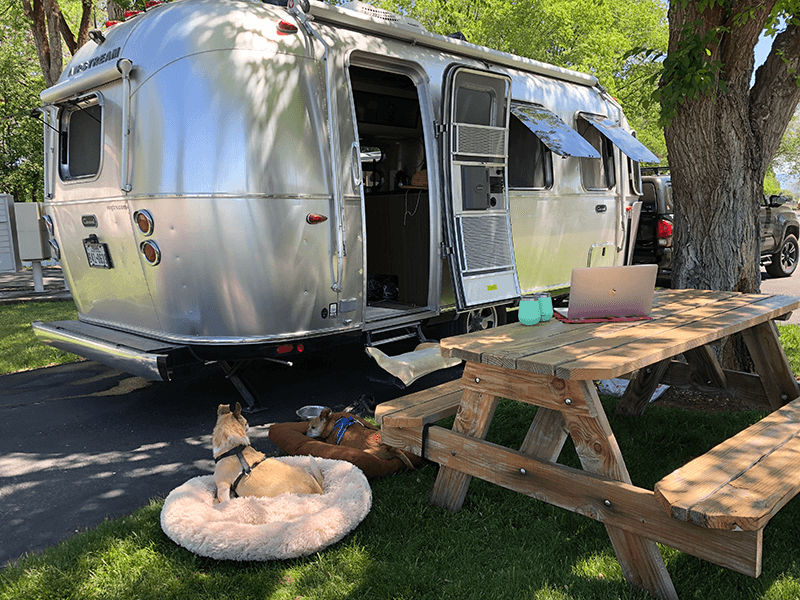
Building a Mobile RV Office Setup
When you live and work on the road, your “office” might be a picnic table in Utah, a dinette in your Airstream, or the front seat of your truck with a dog snoring beside you.
Creating a mobile office that’s both comfortable and functional is the secret to keeping your productivity high — and your back pain low — while you chase the next sunset.
Below are my favorite space-saving tools and digital-nomad essentials to build a work setup that travels as easily as you do.
Portable Desks & Laptop Stands
Working from an RV means every inch counts. You want something compact, lightweight, and easy to stash when it’s time to roll.
Top Picks
- Roost Laptop Stand – Adjustable, ultra-light, and collapsible — raises your laptop to eye level for ergonomic posture even at your dinette table.
- SideTrak Swivel Portable Monitor Mount + Stand – Laptop Dual Screen with Kickstand + Unique Swivel Hinge, Compatible with Mac, PC, Chrome, Powered by USB or Mini HDMI Port (With Case)
- MDF Folding Table for RVs – A compact folding desk that tucks under your bed or couch; ideal for working outdoors or under your awning.
Wally’s Tip: When you’re done, fold your setup away and convert your “office” back into your dinner nook.
Ergonomic Seating for Small Spaces
Long hours editing photos or writing from a stiff dinette bench can wreak havoc on your back. A portable ergonomic chair can make a significant difference.
Top Picks
- GCI Outdoor Comfort Pro Rocker Camping Chair – Lightweight, folds flat, and features a mesh back, making it great for working inside or outside your RV.
- FLEXISPOT Foldex Ergonomic Office Chair, Folding Chair for Small Spaces – A chair/exercise hybrid that lets you pedal lightly while working — perfect for staying active in tight spaces.
- Everlasting Comfort Seat Cushion – Memory foam cushion that turns any RV bench into an ergonomic throne.
Portable Monitors for Work on the Road
Once you’ve had dual screens, it’s hard to go back — even in an RV. Portable monitors make it easy to boost your productivity while keeping your setup light and flexible.
Top Picks
- ASUS ZenScreen MB16ACV 15.6” Portable Monitor – Thin, powered by USB-C, and doubles as a vertical second screen for coding, writing, or Zoom calls.
- SideTrak Solo Pro HD 15.6” Monitor – Freestanding, ultra-slim, with built-in kickstand — ideal for boondock setups.
- Lepow 14” Portable Display – Budget-friendly, light, and durable enough for life on the road.

Checklist: Digital Nomad Office Essentials
Here’s a quick list of must-haves that keep your RV workspace productive, ergonomic, and ready for the road.
✅ Power & Connectivity
- Jackery Explorer 1000 v2 Portable Power Station – Keeps laptops, monitors, and camera gear powered off-grid.
- SpaceX Starlink Mini RV Kit – Reliable internet anywhere, even in remote campsites.
- Nomad Internet Plan – Nationwide unlimited data plan for digital nomads.
✅ Workspace Gear
✅ Comfort & Productivity
- Noise-canceling headphones (Sony WH-1000XM5)
- FYY Travel Cable Organizer Pouch for Tidy Tech Storage.
- Livho Sleep Glasses for up to 99.9% Blue and Green Light Blocking, Ideal for Late-Night Laptop Sessions.
- Gaiatop USB Desk Fan, 3 Speeds Strong Airflow— trust me, it’s worth it during summer boondocking!
Wrapping Up
Your RV office doesn’t need to be fancy — it just needs to fit your life on the road. With a few smart tools, you can edit photos, take client calls, or write your next blog post from anywhere — from a mountain meadow to a desert vista.
And when your workday’s done? Fold up your desk, grab your dog’s leash, and step right outside into the wild. That’s the kind of office culture we can all get behind.
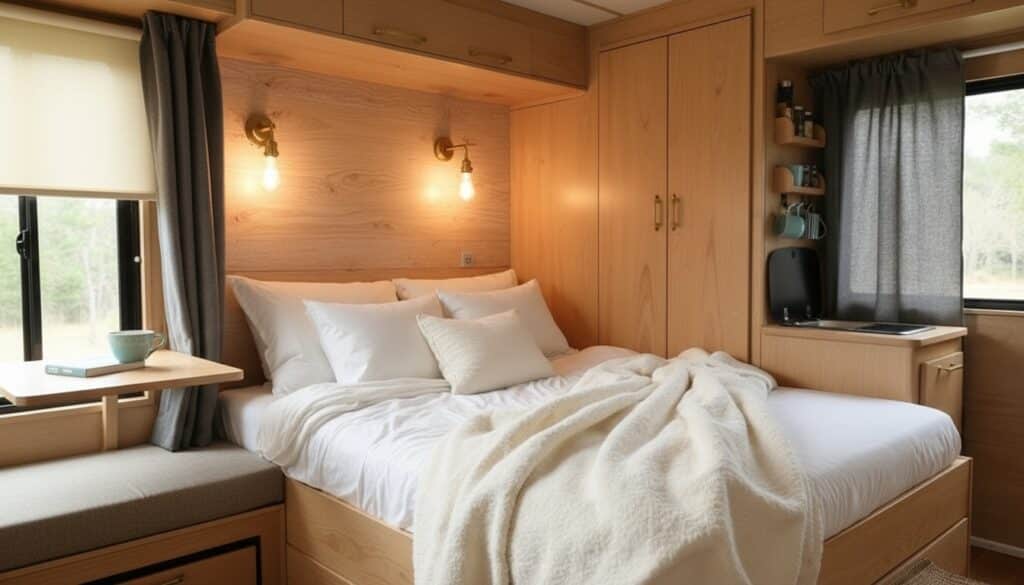
Comfort & Everyday Living Gear
Living on the road doesn’t have to mean sacrificing comfort. Whether you’re parked beneath redwoods or camped at a desert overlook, the right gear can turn your tiny home-on-wheels into a cozy haven.
Below are tried-and-true comfort upgrades that make life in an RV more restful, private, and livable — with affiliate links to my personal favorites.
Best RV Mattresses for Short or Seasonal Stays
Most RV manufacturers seem to think “mattress” means “foam pancake.” If you’ve ever woken up with a crick in your neck after a night in the rig, this section’s for you.
Top Picks
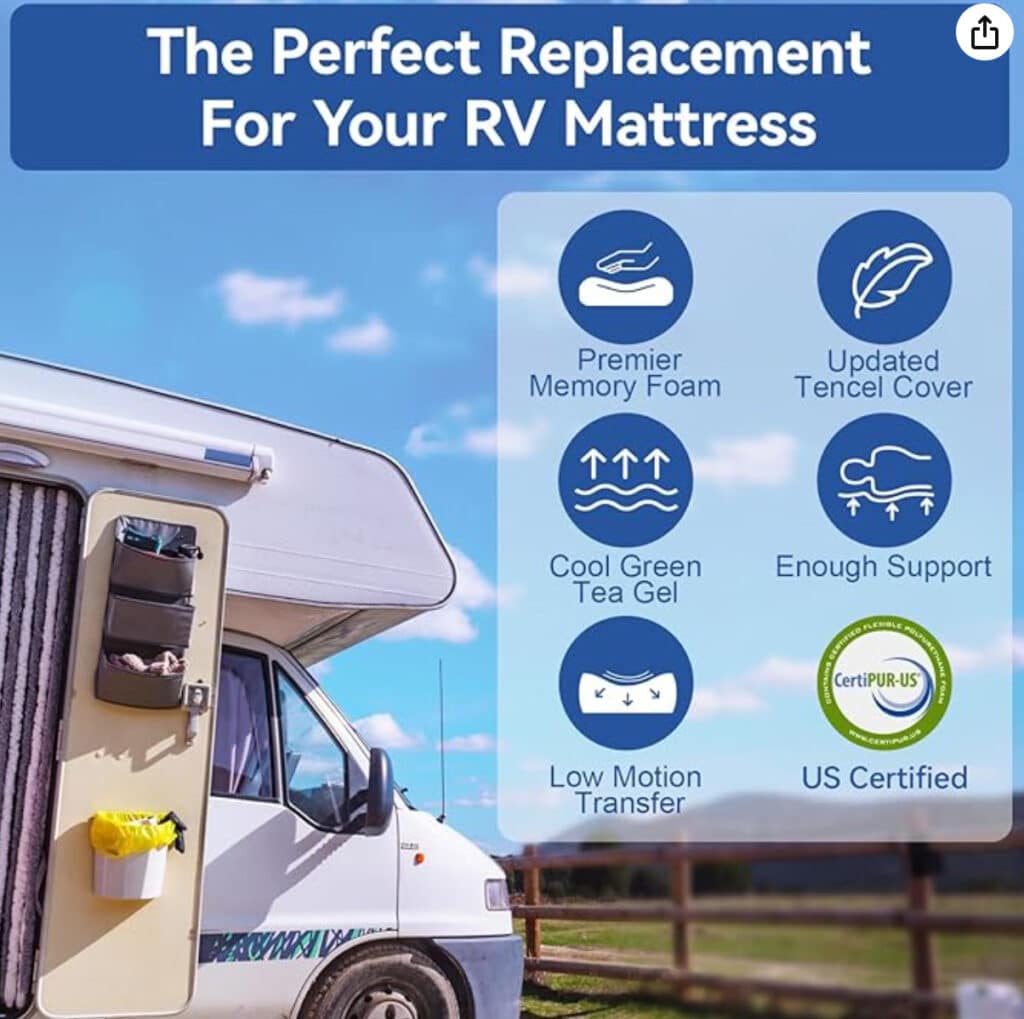
Brooklyn Bedding RV Mattress – Aurora Hybrid Short Queen – Designed specifically for RVs; cooler sleep tech, multiple firmness options, and made in the USA.
Short Queen RV Mattress Memory Foam 10 Inch, Updated Cooling Green Tea/Gel Mattresses for Camper/Truck/Trailer, CertiPUR-US, Made in USA, 75” x 60”
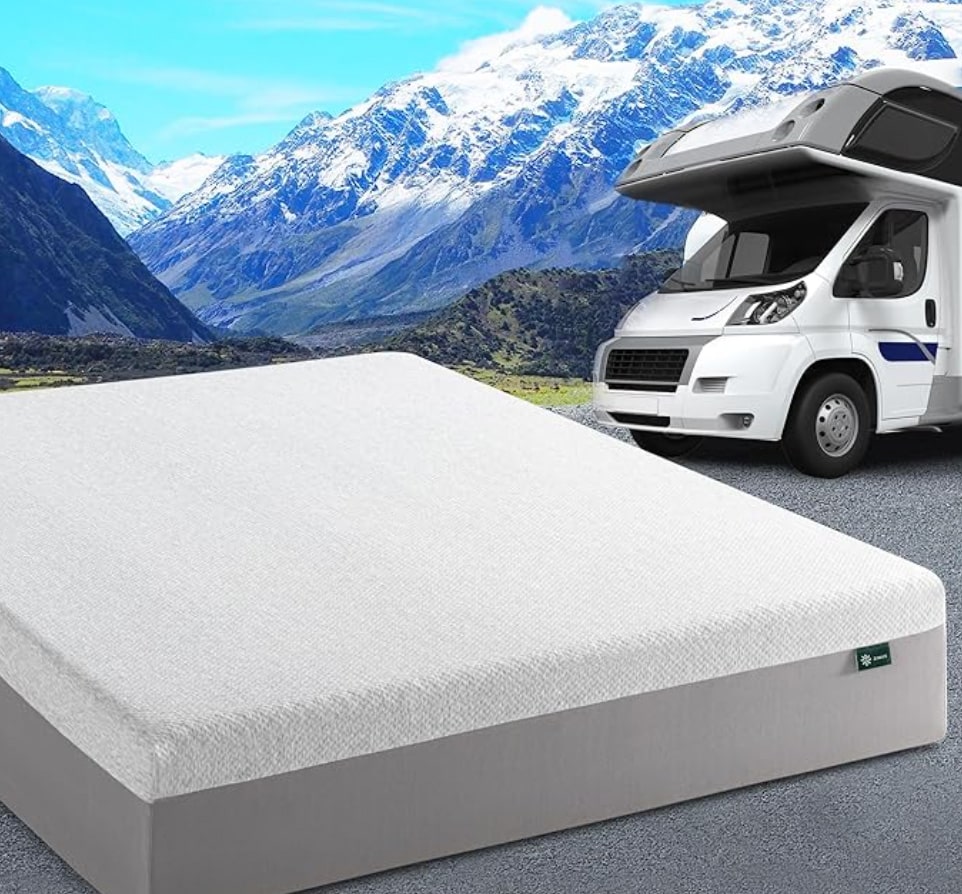
Zinus Green Tea Memory Foam RV Mattress – Affordable, lightweight, and ideal for part-time travelers who want easy installation and great value.
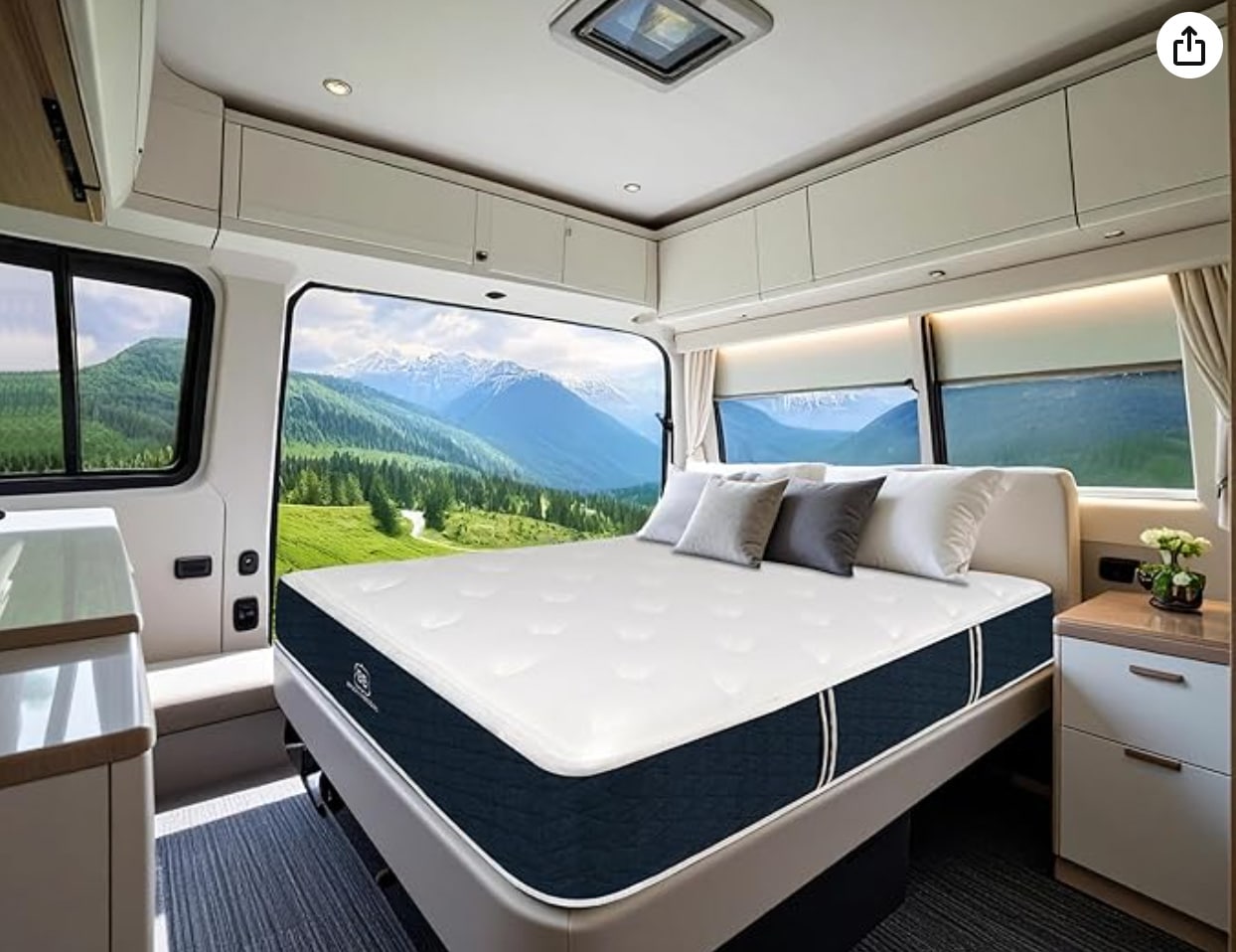
DREAMFOAM Bedding Chill 14″ Gel Memory Foam Mattress– Highly rated by full-timers; contouring comfort with removable, washable cover.
Blackout Curtains & Privacy Solutions
Sunrise at 5 a.m. may look magical, but it’s less romantic when it wakes you up inside your aluminum Airstream. Blackout curtains not only block light but help regulate temperature and add privacy — a huge bonus for solo travelers.
Top Picks
- RV Window Curtains for Inside Camper – Noise-reducing, energy-saving, and easy to hem for RV windows.
- NICETOWN RV Blackout Panels with Velcro Tabs – Customizable lengths for odd-sized RV windows; machine washable.
- RV Door Window Shade Cover – A budget-friendly DIY option for windows and skylights, effectively reducing heat gain.
Climate Control Tools: Heaters, Fans & Dehumidifiers
RVs can swing from sauna to freezer depending on where you’re parked. A few innovative climate tools make all the difference for comfort (and mold prevention).
Top Picks
- Vornado VMH300 Whole Room Heater – Small, quiet, tip-over safe, and ideal for 30-amp setups.
- Dreo Nomad Tower Fan – Slimline tower fan with remote and oscillation — perfect for tight spaces.
- Eva-Dry E-500 Mini Dehumidifier – Rechargeable, silent, and compact — prevents condensation and mildew during humid months.
- Zero Breeze Mark 2 Portable AC – Splurge-worthy cooling for off-grid boondockers (runs off battery or solar).
Wally’s Tip: Place a mini dehumidifier near your dog’s water bowl or under the bed — you’ll be amazed at how much moisture it collects overnight.
Pro Tip: Storage-friendly comfort upgrades
In an RV, everything must earn its keep. Look for comfort items that collapse, compress, or serve multiple functions.
Smart Upgrades
- Vacuum-Seal Storage Bags – Store off-season bedding and jackets under your bed without wasting space.
- ComfyDown Throw Pillow Inserts – Add luxurious comfort that compresses easily for travel.
- Turkish Cotton Throw Blanket – Lightweight, quick-drying, and perfect for layering.
- Collapsible Laundry Basket with Handles – Doubles as a storage bin or dog toy carrier.
Final Thoughts
Comfort in an RV isn’t a luxury — it’s what makes long-term travel sustainable. The right mattress, blackout curtains, and a quiet fan can turn your tiny rig into a sanctuary where you actually look forward to rainy days.
So treat yourself (and your co-pilot pup) to a few of these upgrades. You’ll rest better, breathe easier, and fall even more in love with life on the road.

Power & Energy Solutions for Travelers
Life on the road means staying connected, comfortable, and powered up — whether you’re chasing Wi-Fi signals for work or keeping the fridge cold in a desert boondock. Your energy setup is the backbone of RV life, and the right gear can make or break your off-grid adventures.
Portable solar panels, such as the Jackery SolarSaga 100W or 200W, provide plug-and-play convenience for weekend getaways or shaded campsites where a quick energy boost is needed. For more committed travelers, roof-mounted kits such as the Renogy 200W ShadowFlux Roof Kit or a Bluetti AC200Max + 400W roof combo provide a reliable long-term setup that can keep laptops, fridges, and small appliances running for days.
Beyond the panels, smart power management tools — inverters, MPPT charge controllers, and battery monitors — help you optimize every watt of energy you collect. Backup power stations from Jackery, Goal Zero, and Bluetti also give digital nomads peace of mind when cloudy days or extra devices push your system’s limits.
If you’re ready to dive deeper into building your RV energy setup — including cost, setup comparisons, and gear recommendations — check out my complete guide:
👉 Best Solar Panels for RV Living Off-Grid (2025)
It’s your roadmap to understanding portable vs. roof-mounted systems, backup batteries, and how much solar power you actually need to work (and live) off-grid with confidence.
If you’re ready to start your solar setup, choosing portable or roof-mounted solar panels, along with a portable power station, will cover you for most of your off-grid adventures.
Jackery SolarSaga 200W
Jackery SolarSaga 200W panels fold into a briefcase-style carry case.
Ultra Fast Solar Charging, Highly Compatible, Easy Setup
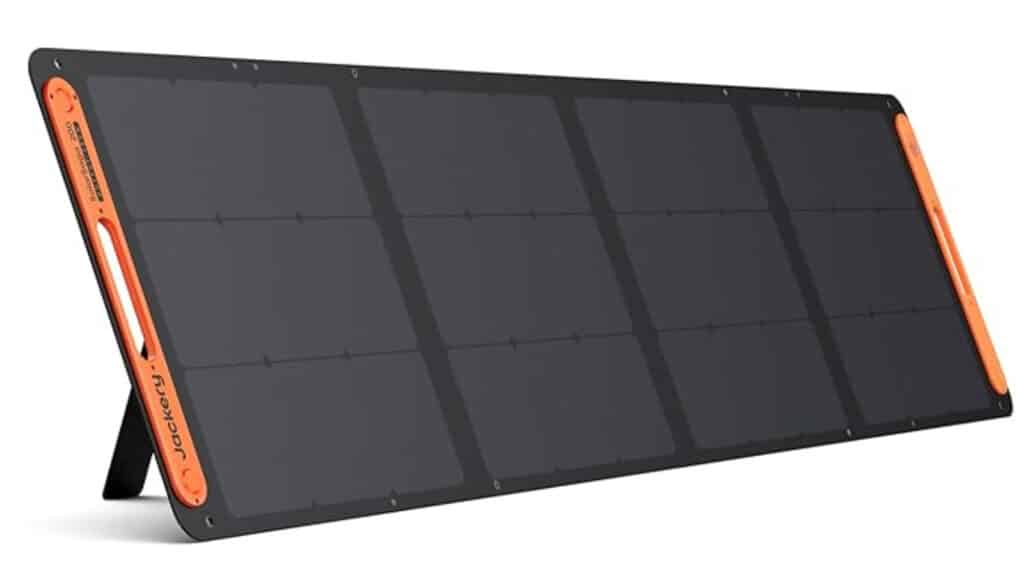
Renogy 200W ShadowFlux Roof Kit
Delivers enhanced power generation even in shaded areas caused by buildings, plants ensuring reliable power output.

BLUETTI AC200L Portable Power Station
45 Min. Fast Recharge, 11 Ports for All Needs, Multiple Expansion Batteries
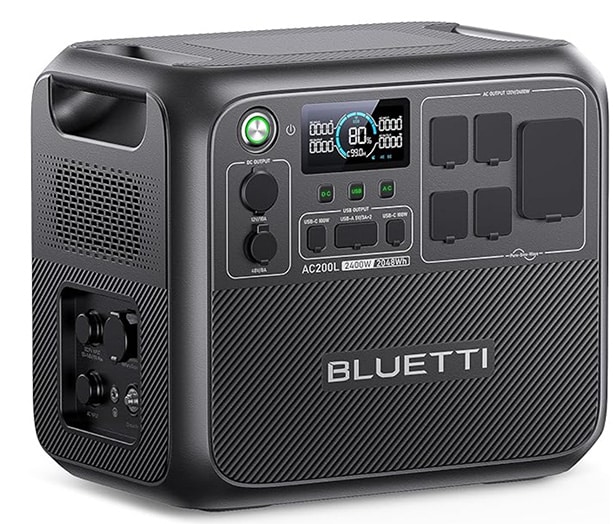
Jackery SolarSaga 100W — “I love this foldable panel for its ultra-lightweight design and easy setup. Great for weekend trips or as a solar “boost” in shady campsites.”
Renogy 200W ShadowFlux Anti-Shading Solar Panel— “This kit gives excellent bang for your buck. A reliable, upgradeable option for part-time RVers who want a balance of cost and capacity.”
Bluetti AC200L Portable Power Station — “This combo handled my entire rig during a week of off-grid work. It’s powerful enough to run my laptop, fridge, and small appliances simultaneously.”
Each of these brands has earned its reputation for quality and durability — they’ve powered my Airstream across deserts, forests, and coastlines without fail.
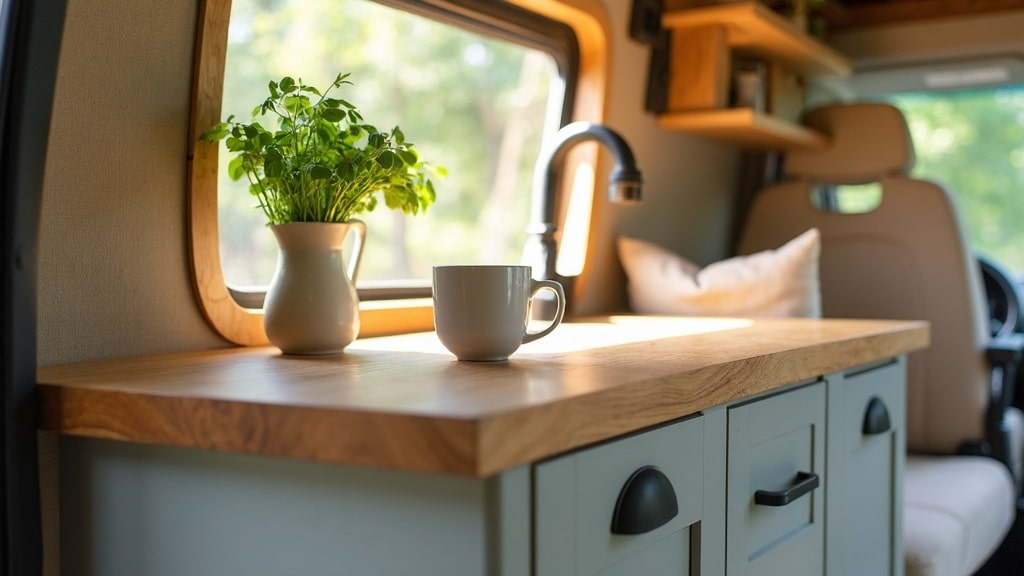
Kitchen & Cooking Essentials on the Road
When your entire kitchen fits in a few drawers and a two-burner stove, every inch — and every watt — counts. But that doesn’t mean you can’t eat well on the road. With the right compact cookware and smart appliances, you can whip up everything from sunrise coffee to campground stir-fry without breaking a sweat (or blowing a fuse).
Below are my road-tested cooking essentials for RV living — small-space friendly, easy to clean, and chosen to make life on the road both delicious and simple.
Compact Cookware & Space-Saving Appliances
Think multi-purpose, stackable, and energy-efficient. These tools make it easy to cook fresh meals without cluttering up your countertop.
Top Picks
- Instant Pot Duo Mini 3-Quart Multi-Cooker – A total RV hero. It pressure-cooks, slow-cooks, steams, and makes rice — all in one small footprint.
- CHEFMAN 2 Qt Mini Air Fryer – Digital Space-Saving Compact Air Fryer – Ideal for single travelers or couples, perfect for quick reheats or crispy veggies without needing to turn on the oven.
- Magware Magnetic Flatware Set – Reusable, lightweight utensils that snap together magnetically. Perfect for eco-conscious RVers.
- RVGUARD RV Stove Top Cover Board, Countertop Cutting Board– Doubles your prep space and keeps your stove protected while traveling.
- Collapsible Bowls, 3pcs Food Grade Silicone Camping Bowl– Stack flat when not in use, and can handle both prep and serving.
Wally’s Tip: Keep one pan and one pot that can go from stovetop to campfire — less gear, more adventure.
Collapsible Dishware & Storage Hacks
RVers live by one golden rule: if it collapses, nests, or stacks, it earns its spot in the kitchen.
Top Picks
- Sea to Summit X-Set 31 Collapsible Cook Set – Includes collapsible pot, bowl, and mug. Packs down to 1.5 inches high.
- Joseph Joseph Nest 9 Compact Food Prep Set – Mixing bowls, measuring cups, and colander all nest perfectly.
- OXO Good Grips POP Storage Containers – Airtight, modular, and fantastic for dry goods — no more spilled pasta mid-drive!
- Stasher Silicone Reusable Bags – Replace plastic bags; freezer-, microwave-, and dishwasher-safe.
Coffee Makers for RV Nomads
If you’re like me, the day doesn’t start until the coffee’s brewed. Whether you’re hooked to shore power or boondocking in the desert, there’s a perfect RV-friendly coffee solution for every caffeine lover.
Top Picks
- AeroPress Go Travel Coffee Maker – Compact, no electricity needed, and makes a smooth, rich cup.
- InkTrail Portable Electric Espresso Machine, Travel Coffee Maker for Camping– Tiny but mighty pod espresso maker for 120V hookups or inverter setups.
- Keurig K-Mini Single Serve – Slim profile, easy cleanup, and perfect for one mug at a time.
- Stanley Pour Over Coffee Set – For minimalist campers — stainless steel, no filters needed.
- Wacaco Nanopresso Portable Espresso Maker – Hand-pumped espresso anywhere; great for off-grid mornings.
Pro Tip: Store your coffee gear in a shallow bin with mugs, filters, and beans — your morning ritual stays organized and ready to roll.
Quick List: 5 Must-Have Kitchen Tools for RV Life
- Instant Pot Duo Mini – One pot, seven functions — less clutter, more flavor.
- Collapsible Silicone Strainer – Snaps flat and tucks under the sink.
- Magware Flatware Set – Snap-together utensils that save space in your drawer.
- Stasher Silicone Bags – Sustainable Storage for Leftovers or Produce.
- AeroPress Go Coffee Maker – Brew coffee anywhere — no electricity required.
Final Thoughts
A well-stocked RV kitchen isn’t about having more gear — it’s about having the right gear. These space-saving tools and compact appliances keep meal prep fun, easy, and efficient, whether you’re parked at a Harvest Host vineyard or boondocking by a mountain lake.
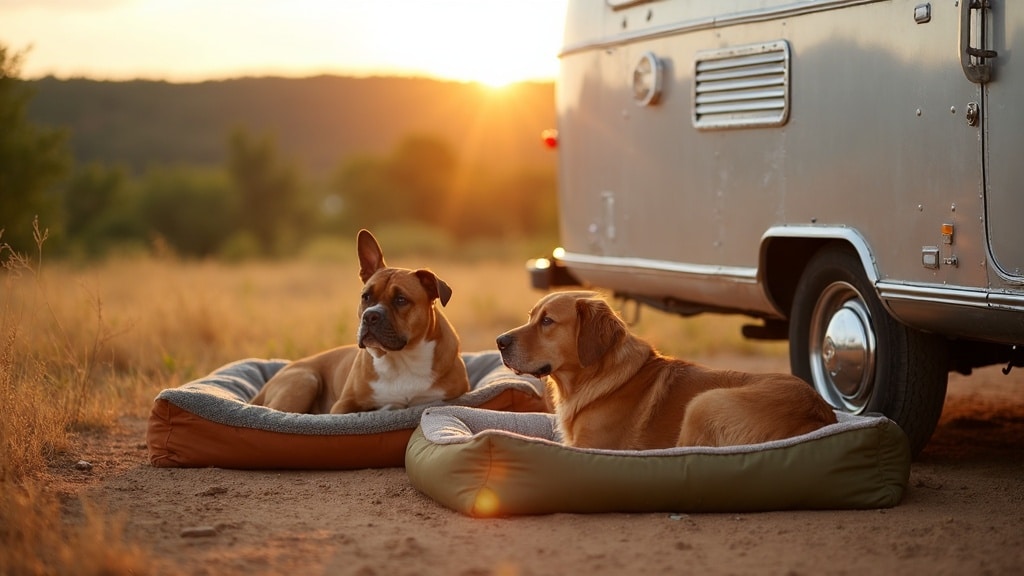
Pet Gear for Digital Nomads
Let’s be honest — our pets are the real bosses of RV life. Whether your copilot rides shotgun or naps under your desk during Zoom calls, keeping them safe, hydrated, and comfortable on the road is a top priority. After thousands of miles with my dog, Wally, I’ve learned which pet gear truly earns its spot in the rig — compact, easy to clean, and adventure-ready.
Portable Dog Beds & Travel Water Bowls
Every RV dog needs a cozy corner — and gear that travels as well as they do. Choose items that are lightweight, washable, and can double as camping gear or car rides.
Top Picks
- Ruffwear Basecamp Dog Bed – Low-profile and rollable; perfect for small spaces or under tables.
- Chuckit! Travel Bed – Folds into its own stuff sack; machine washable and water-resistant.
- RUFFWEAR Quencher Collapsible Bowl – The original collapsible travel bowl — ideal for hikes and roadside breaks.
- Kurgo Splash-Free Travel Bowl – Silicone and weighted for RV travel; reduces spills when you’re on the move.
- Outward Hound Port-A-Bowl – Budget-friendly, packable water bowl for daily use.
Wally’s Pick: The Quencher Bowl — it’s survived Baja sand, Oregon mud, and still packs flat in the door pocket.
Pet Safety Gear: Harnesses & Seat Belts
RV safety isn’t just for humans. A properly secured pet harness or seat belt keeps your dog safe during sudden stops — and protects both of you if there’s an accident. Look for crash-tested, car-approved designs.
Top Picks
- Kurgo Tru-Fit Smart Harness with Seat Belt Tether – Crash-tested up to 75 lbs, includes car seat tether, and doubles as a walking harness.
- Ruffwear Load Up Vehicle Harness – Designed for safe, certified vehicle travel, this harness is adjustable and padded for added comfort.
- Sleepypod ClickIt Sport Harness – Top-rated safety harness used by professional travelers; excellent for larger dogs.
- AmazonBasics Adjustable Pet Barrier – Keeps curious dogs safely in the backseat or RV cab area.
Pro Tip: Attach your dog’s seat belt tether to a rear seat latch or frame-mounted anchor, not a headrest. It’s stronger and safer in sudden stops.
Cooling Mats & Travel Accessories for Hot Climates
From desert boondocks to humid coastlines, keeping your dog cool is crucial — especially for older pets or those with thick coats. These cooling mats and heat-beating accessories make summer travel more comfortable (and safer) for your furry co-pilot.
Top Picks
- Rywell Cooling Gel Dog Mat – Pressure-activated cooling pad that fits under beds or in kennels.
- RUFFWEAR Swamp Cooler Harness – Evaporative cooling vest; soak it in water for hours of temperature relief.
Wally’s Tip: Freeze a damp microfiber towel overnight, then drape it over your dog’s cooling mat on extra-hot days. Instant A/C!
Quick List: Road-Tested Pet Essentials for RVers

Ruffwear Quencher Bowl – Lightweight, packable hydration. The original packable dog bowl, offering a lightweight, packable way to make sure your pooch gets dinner, or water, no matter where you go.

Kurgo Tru-Fit Smart Harness with Seat Belt Tether – Crash-tested up to 75 lbs, includes car seat tether, and doubles as a walking harness.
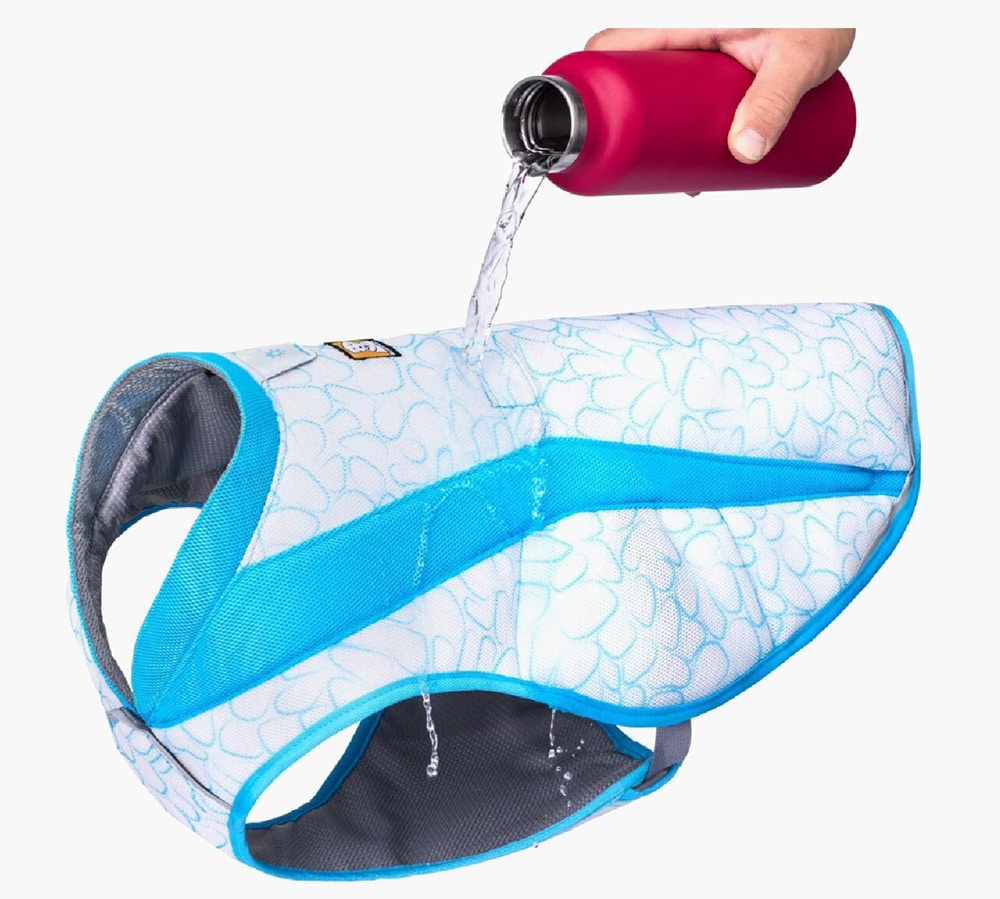
RUFFWEAR Swamp Cooler Vest – Cooling comfort for hot hikes. It provides a high level of sun protection and shade coverage on hot, sun-exposed trails.
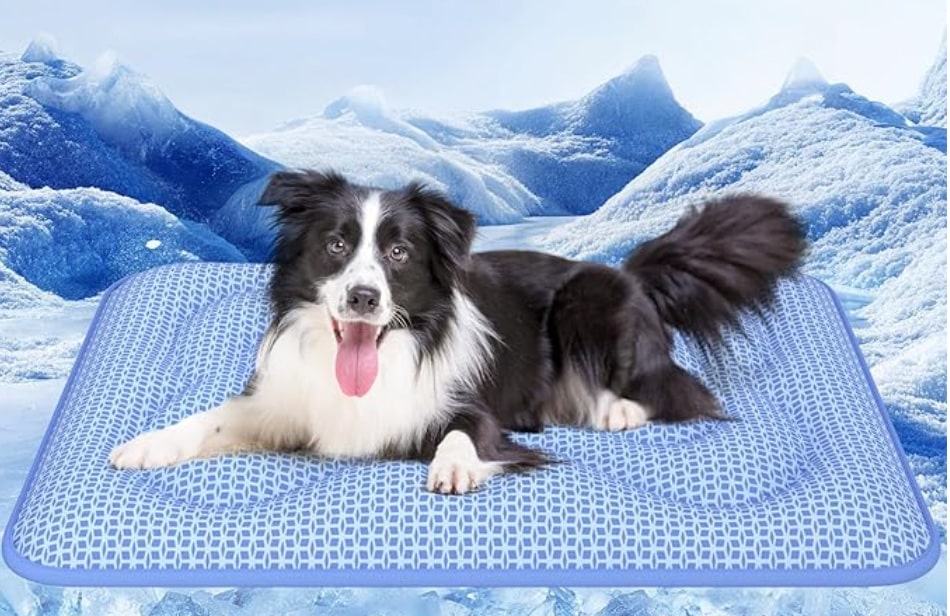
Rywell Dog Cooling Mat– Keeps your pup comfy and cool. Super Thick & Comfortable Cooling Mat for Large Dog with Arc-Chill 3.0 Endothermic Color Changing & Dual Sided for All-Year Use, Portable
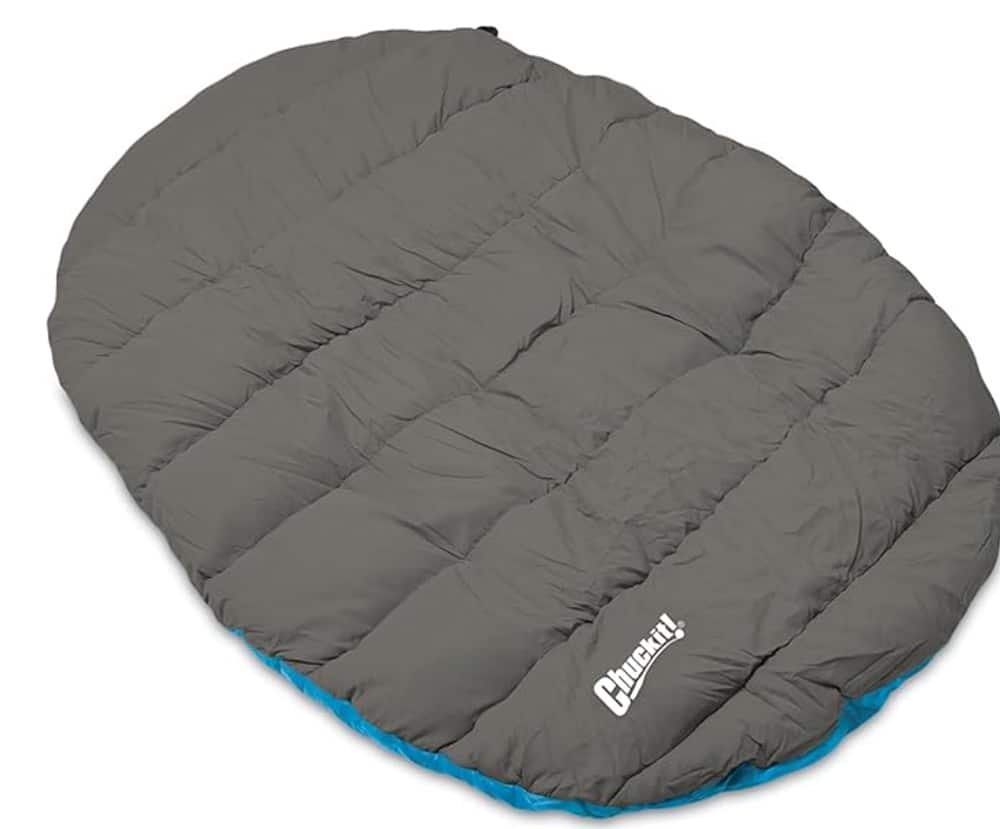
Chuckit! Travel Bed – Folds into its own stuff sack; machine washable and water-resistant.
Final Thoughts
Your pet’s comfort and safety on the road make all the difference — and they deserve the best. With a few smart investments, your dog’s travel setup can be just as cozy and functional as your own.
Because when Wally’s happy, I’m happy — and a comfortable co-pilot means more miles, more trails, and a lot more tail wags ahead.

Safety & Security Gear Every RVer Needs
Feeling secure on the road isn’t just peace of mind — it’s what lets you relax, sleep well, and actually enjoy your travels. Whether you’re parked at a quiet Harvest Hosts winery or boondocking on public lands, a few simple security upgrades can make your rig feel as safe as home.
Upgraded Door Locks & Portable Safes
Most factory RV locks are… let’s say “optimistic.” Many use the same key pattern across multiple models! Upgrading your entry and compartment locks is one of the simplest, most effective ways to deter opportunistic theft.
Top Picks
- RVLock Keyless Entry Handle w/ Integrated Keypad & Fob – Easy DIY install; keypad + remote for one-touch locking, ideal for Airstreams, Jaycos, and more.
- Master Lock Portable Safe (P008EML) – Compact digital safe for passports, jewelry, and cash; fits under most RV beds.
Wally’s Tip: Keep spare keys in a Magnet Key Holder Safe under your tow vehicle — not in your RV bumper!
Security Cameras & Dash Cams for RVs
Modern RV cameras double as both security and travel companions. You can monitor your rig from your phone, record scenic drives, or keep an eye on your dog while you’re away from camp.
Top Picks
- Ring Stick Up Cam Battery HD security camera – Wireless indoor/outdoor camera; works via Wi-Fi or mobile hotspot, easy to mount near the entry door.
- Blink Outdoor 4 – Wireless smart security camera – Two-year battery life, motion alerts, and Alexa integration for remote monitoring.
- Garmin Dash Cam 57, 1440p and 140-degree FOV, Monitor Your Vehicle While Away– Compact dash cam with 1440p video, parking guard mode, and voice control.
- Nextbase 622GW 4K Dash Cam – Top-tier dash cam for long-haul RVers; includes emergency SOS alert and image stabilization.
Pro Tip: Use a DC Power Splitter Adapter to power your dash cam and GPS simultaneously without draining the RV battery.
Essential Safety Detectors (CO, Propane, Smoke)
A properly maintained safety-detector setup can literally save your life. Many RVs ship with outdated or expired sensors — replacing them every 5–7 years is essential.
Top Picks
- Safe-T-Alert 35-742 RV Dual LP/CO Detector – Combination propane and carbon monoxide detector; 12V hard-wired and RV-rated.
- Kidde Smoke & Carbon Monoxide Alarm with Voice Alerts – Battery-powered backup for older rigs; loud, clear voice alarm.
- First Alert 3-in-1 Smoke, Fire & CO Detector (Z-Wave) – Connects to smart hubs like Alexa or Ring for real-time mobile alerts.
- Honeywell Home Wi-Fi Leak Detector – Place under sinks or near water heaters to catch leaks before they cause costly damage.
FAQ: How Can I Keep My RV Safe While Boondocking?
- Lock up everything. Use a Trimax Universal Wheel Chock Lock or Proven Industries Coupler Lock to secure your trailer or tow vehicle.
- Install motion lights. Battery or solar lights, such as LECLSTAR Solar Motion Lights, discourage visitors at night.
- Keep valuables out of sight. Portable safes and tinted windows help deter curiosity.
- Stay connected. Use an InReach Mini 2 Satellite Communicator for emergency contact, even when there’s no cell service.
- Trust your instincts. If something feels off — move. Mobility is your most significant advantage as an RVer.
Wally’s Boondocking Wisdom: “Mark your territory with solar lights and keep a squeaky toy near the door. Nobody sneaks up on a dog with good ears.”
Final Thoughts
Safety gear might not be glamorous, but it’s the foundation of confident, carefree RV travel. A secure rig means you can focus on the good stuff — chasing sunsets, brewing camp coffee, and living your digital-nomad dream with your four-legged sidekick by your side.
Take an hour this week to check your locks, update detectors, and add one new layer of protection. Peace of mind is the best travel upgrade you’ll ever buy.
Packing Smart: The RV Digital Nomad Checklist
When you’re living, working, and exploring from a few hundred square feet, every ounce and outlet matters. The goal isn’t to bring everything — it’s to bring what actually makes life easier.
After years of full- and part-time RV travel, I’ve found that packing by category keeps things simple, organized, and stress-free. Here’s how to do it.
How to Travel Lighter Without Sacrificing Needs
- Choose dual-purpose items. A cutting board that doubles as stove cover, a fan with USB ports, a dog bed that rolls into a car seat cover — these earn gold stars in an RV.
- Follow the “1-in, 1-out” rule. For every new gadget or T-shirt you add, remove one. Space is your most valuable currency.
- Go digital wherever possible. Replace bulky paper maps, guidebooks, and even journals with lightweight digital tools like Notion or Google Drive.
- Re-evaluate seasonally. Every three months, ask: “Have I used this?” If not, it’s a donation or storage bin item.
- Prioritize comfort over quantity. One great coffee mug, one supportive pillow, one reliable pair of hiking shoes — quality wins every time.
Pro Tip: Pack like a minimalist, live like a pro traveler. The less time you spend searching for stuff, the more time you’ll spend exploring.
Free Download
Free Download: RV Gear Checklist (Email Opt-In)
Want my printable version of this checklist?
Get the “RV Digital Nomad Packing List” — a one-page PDF of my go-to gear for work, comfort, kitchen, and pet life.
Download the Free RV Gear Checklist (or join the Wally Pack Newsletter to get it instantly!)
🌄 Final Thoughts
The truth about RV life isn’t that it’s glamorous — it’s that it’s possible. With the right mix of tech, comfort, and mindset, anyone can work, travel, and live meaningfully on the road. The gear just helps make that dream sustainable.

![Top 5 Best RV Water Filters for Clean and Pure Drinking Water [2025] 22 Mesa Falls, Idaho is part of the Mesa Falls Scenic Byway](https://travelswithwally.com/wp-content/uploads/2021/06/mesa-falls-e1670204939574-768x616.png)



![KÜHL Women's Kontour™ Short 8-Inch Review [2025] 27 KUHL Women's Kontour Short](https://travelswithwally.com/wp-content/uploads/2025/06/IMG_0860-768x576.jpg)
